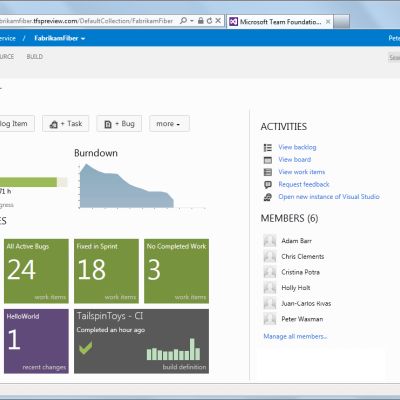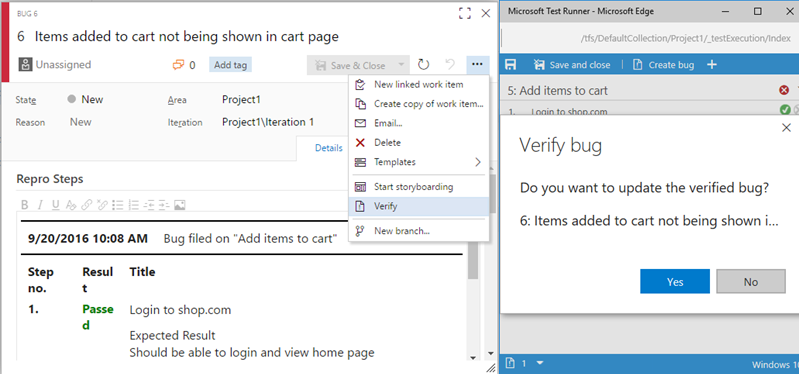

- What does microsoft team foundation server do update#
- What does microsoft team foundation server do manual#
- What does microsoft team foundation server do upgrade#
- What does microsoft team foundation server do windows#
If you want to use Kerberos, it should just work (so long as you have set things up properly outside of TFS).
What does microsoft team foundation server do update#
When we added both the Negotiate and NTLM security support providers, however, we could not find any clients which worked with our old default settings (just NTLM) and failed with the updated settings (Negotiate and then NTLM, in that order).Īs such, we decided not just to update the default setting, but also to remove the need for customers to make any decisions about the supported providers. (Another part of this effort was the set of changes around recommending the use of HTTPS bindings and an effort to make doing so easier.) After a bunch of testing, we discovered that using only the Negotiate provider would negatively impact certain clients.
What does microsoft team foundation server do windows#
TFS had been using NTLM as an explicit default setting for the Windows Authentication security support provider for a long time, but in TFS 2017 we decided to comply with the SDL recommendation here as part of an overall push to make TFS more secure by default. Negotiate selects Kerberos unless it cannot be used by one of the systems involved in the authentication.” Currently, the Negotiate security package selects between Kerberos and NTLM. Negotiate allows your application to take advantage of more advanced security protocols if they are supported by the systems involved in the authentication. “ Your application should not access the NTLM security package directly instead, it should use the Negotiate security package. For example, (v=vs.85).aspx has the following paragraph: This same recommendation can be found in various other public documents. Instead, the SDL recommendation is to always use the Negotiate security support provider, which will attempt to use Kerberos, but will fall back to NTLM if Kerberos cannot be used. The Microsoft Security Development Lifecycle was updated a while back to forbid explicit selection of the NTLM security support provider, due to various vulnerabilities in the protocol – see, for example. The point of this blog post is to explain the change in a bit more detail and to reduce the confusion we mistakenly caused.įirst, some backstory. We underestimated the detail-orientedness of our customers, however, and many people both noticed the change and mistakenly thought that they needed to react to it. We didn’t anticipate this change attracting much notice, since we had ensured (through extensive testing) that there would not be any impact for existing TFS deployments and since we were making things simpler by taking away a little-used decision point during advanced configuration scenarios. The focus has been on improving the experience for Git users, since (as I said) Git has a very different workflow than TFVC, and Git support was only added in TFS 2013, so it has a lot of catching up to do.In Team Foundation Server 2017 we made a change to the default security support providers used by our IIS site for Windows Authentication. Both are considered first-class citizens and are going to continue to be supported and receive new features for the foreseeable future. The other option is Git, which is a distributed version control system with a radically different workflow. It's a centralized version control system, similar in paradigm to Subversion. Team Foundation Version Control is one of the two native options for source control in TFS/Team Services.

What does microsoft team foundation server do upgrade#
The upside here is that there's no infrastructure to maintain or software to upgrade - upgrades happen every 3 weeks, with no downtime.

For example, Team Services does not have SharePoint integration or reporting. There are some capabilities in TFS on-prem that aren't available in Team Services and vice versa. It's the exact same codebase as TFS on-prem, except it's updated more frequently (every 3 weeks). Team Services is "TFS in the cloud", hosted and maintained by Microsoft in the Azure data centers. It's called Visual Studio Team Services these days. There is no such thing as "Team Foundation Service" anymore. TFS is an on-premise solution, consisting of (in a best-practices style setup) anywhere from 2 to 5 servers. Since then it's received 5 major versions (2008, 2010, 2012, 2013, and now 2015) with innumerable service packs, patches, and quarterly updates. It's been around for about 10 years now, introduced in 2005 as Visual Studio Team System. It also has SharePoint integration and a data warehouse to facilitate easy reporting.
What does microsoft team foundation server do manual#
It contains capabilities for Agile project management, source control, continuous integration (build), continuous delivery (release), manual test case management, and more. Team Foundation Server is Microsoft's "all-in-one" Application Lifecycle Management solution.


 0 kommentar(er)
0 kommentar(er)
